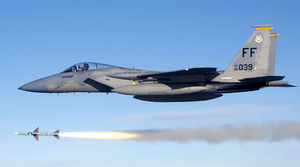F-15 Eagle
The F-15 Eagle aircraft is a series of air superiority fighters, designed for the United States Air Force. Production began with the F-15A single-seat and F-15B two-seat (trainer) versions; the current U.S. production versions are the F-15C and F-15D. In the system of fighter generations, it is usually considered fourth generation.
While an informal motto for the designers was "not a pound for air to ground", a two-seat fighter-bomber variant, the F-15E Strike Eagle, has proved to be a formidable combat performer.
Both the F-15 and F-15E will be replaced by the fifth generation F-22 Raptor.
Role
Before the F-15E was developed, the F-15 series was seen as a "high end" air superiority fighter. Under John Boyd's concept of "high-low", the F-16 Fighting Falcon was the Air Force low end, intended as a fighter-bomber although having significant air superiority capability.
The first F-15A flight was made in July 1972, and the first flight of the two-seat F-15B (formerly TF-15A) trainer was made in July 1973. The first Eagle (F-15B) was delivered in November 1974. F-15s can extend their range both with aerodynamically efficient conformal fuel tanks that effectively become part of the fuselage, as well as wing-mounted drop tanks. Still, they routinely use air refueling.
In January 1976, the first Eagle destined for a combat squadron was delivered. In 1983, a Multistage Improvement Program was begun, with the first production MSIP F-15C produced in 1985. Improvements included an upgraded central computer; a Programmable Armament Control Set, allowing for advanced versions of the AIM-7 Sparrow, AIM-9 Sidewinder, and AIM-120 AMRAAM air-to-air missiles; and an expanded Tactical Electronic Warfare System that provides improvements to the AN/ALR-56C radar warning receiver and AN/ALQ-135 countermeasure set.
The final 43 included a Hughes AN/APG-70 radar, of which Version 1 is a PESA system, but version 2, being deployed experimentally, is a radically improved APESA system
F-15C, D and E models were deployed to the Persian Gulf in 1991 in support of Operation Desert Storm where they proved their superior combat capability. F-15C fighters accounted for 34 of the 37 Air Force air-to-air victories. They have since been deployed for air expeditionary force deployments and Operation Southern Watch (no-fly zone in Southern Iraq), Operation Provide Comfort in Turkey, Operation Allied Force in Bosnia, Operation Enduring Freedom in Afghanistan and Operation Iraqi Freedom in Iraq.
Foreign operators
There are a number of foreign operators, including Israel, Japan, and Saudi Arabia, with variants specific to national needs and U.S. export controls.
Defensive systems
For both electronic protection and infrared countermeasures, the AN/ALE-47 Countermeasures Dispenser System [CMDS], is a "smart" dispenser that can integrate with defensive avionics such as radar warning receivers, radar reflector (i.e., chaff) dispensers, radar jammers, as well as helping the pilot with situational awareness of the threat. [1]
Specifications
- Primary function: Tactical fighter
- Contractor: McDonnell Douglas Corp.
- Power plant: Two Pratt & Whitney F100-PW-100, 220 or 229 turbofan engines with afterburners
- Thrust: (C/D models) 23,450 pounds each engine
- Wingspan: 42.8 feet (13 meters)
- Length: 63.8 feet (19.44 meters)
- Height: 18.5 feet (5.6 meters)
- Weight: 31,700 pounds
- Maximum takeoff weight: (C/D models) 68,000 pounds (30,844 kilograms)
- Fuel Capacity: 36,200 pounds (three external plus conformal fuel tanks)
- Payload: depends on mission
- Speed: 1,875 mph (Mach 2 class)
- Ceiling: 65,000 feet (19,812 meters)
- Range: 3,450 miles (3,000 nautical miles) ferry range with conformal fuel tanks and three external fuel tanks
- Crew: F-15A/C: one. F-15B/D/E: two
- Armament: One internally mounted M-61A1 20mm 20-mm, six-barrel cannon with 940 rounds of ammunition; four AIM-9L/M Sidewinder and four AIM-7F/M Sparrow air-to-air missiles, or eight AIM-120 AMRAAMs, carried externally.
- Unit Cost: A/B models - $27.9 million (fiscal 98 constant dollars);C/D models - $29.9 million (fiscal 98 constant dollars)
- Initial operating capability: September 1975
- Inventory: Total force, 522
Successor
For the United States, the successor to the F-15 air superiority and probably advanced fighter bomber series is the F-22 Raptor.
- ↑ NAVAIR Electronic Warfare Software Support Activity (EWSSA), System Support: ALE-47
